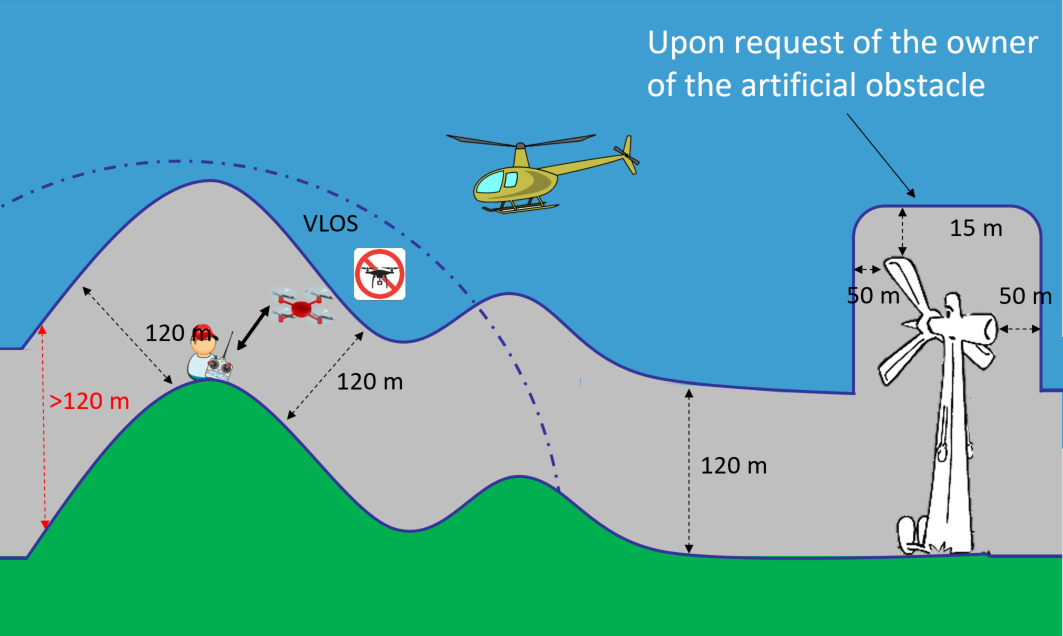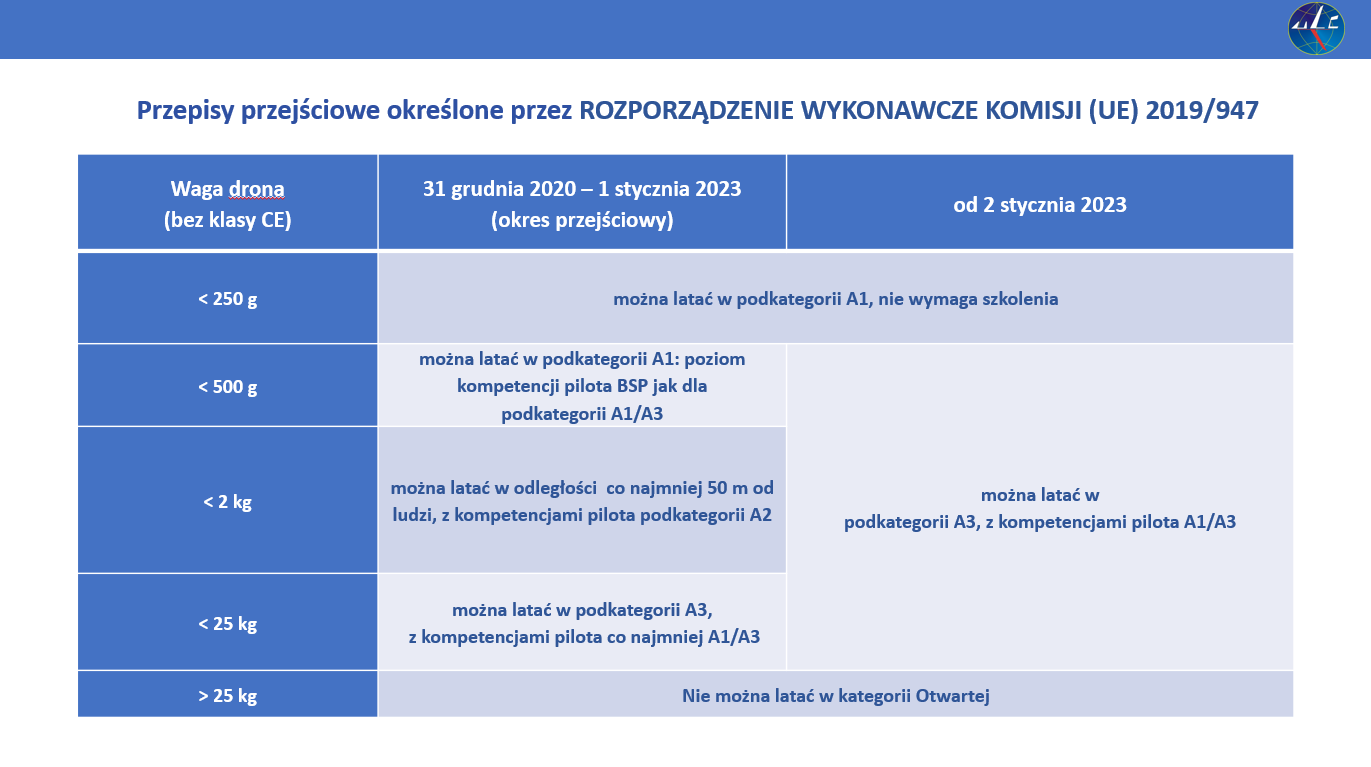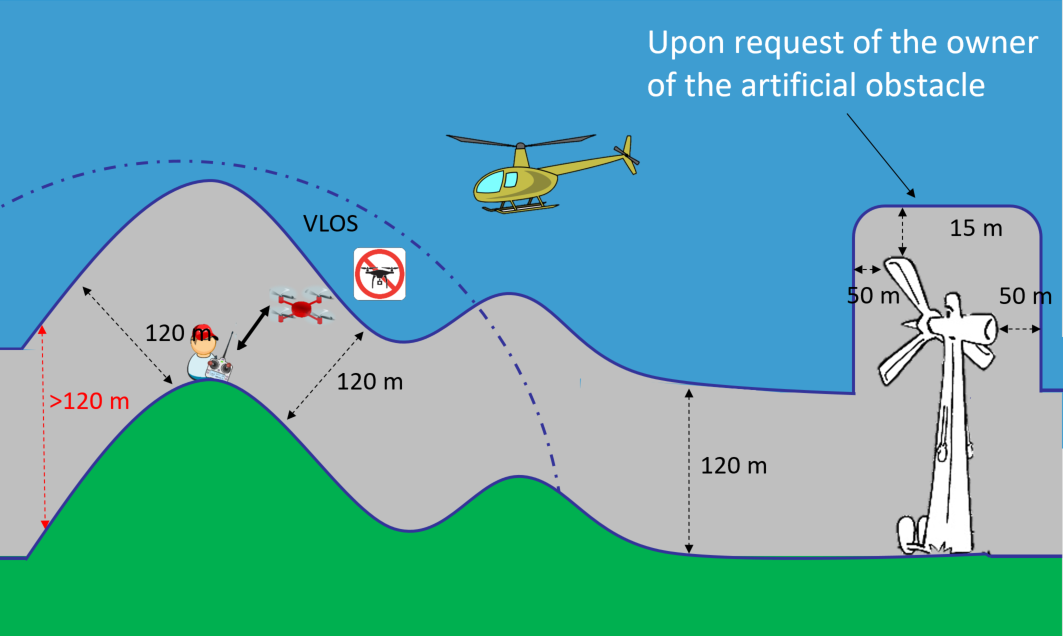CURRENT REGULATIONS FOR DRONE USERS IN POLAND AND THROUGHOUT THE EUROPEAN UNION (2021) - OPEN CATEGORY

CURRENT REGULATIONS FOR DRONE USERS IN POLAND AND THROUGHOUT THE EUROPEAN UNION (2021) - OPEN CATEGORYA
On 31.12.2020 the rules for drone users across the European Union changed. The EU authority that sets the following rules is EASA. In the following post, we want to introduce the rules for drone use in the open category.
This knowledge is necessary in order to use drones safely and not to expose yourself to legal and financial consequences. Failure to comply with the rules can result in up to 5 years imprisonment, which should be a good motivation to learn the most important information for drone owners and pilots.

Table from ULC website
The rules are not complicated, but require citizens wishing to use their drones to follow certain rules. The open category is divided into three subcategories: A1, A2 and A3.
The A1 and A3 category ratings can be obtained free of charge by completing a free online course followed by a free exam, which is also taken online. The course and exam contain essential information that should be learnt by anyone wishing to fly a drone in the EU, including Poland.
The A2 subcategory course is also free and online, but the exam requires a fee (30 PLN) at one of the authorised certification bodies available on the ULC website. It is worth mentioning that for amateurs, owners of popular drones available for sale and meeting the conditions described by ULC A2 category is not needed. Links and glossary of basic terms are provided at the end of this article.
KEY INFORMATION ON CURRENT LEGISLATION:
Operations in the 'open' category allow low-risk flights. They do not require a prior permit to fly from the CAA. Operations in the "open" category may only be performed within the visual range of the pilot or observer at a distance of no more than 120 metres from the nearest point of the ground surface, with drones weighing no more than 25 kg.

The open category is divided into three subcategories A1, A2 and A3, based on operational restrictions and requirements for UAV and drone pilots:
- A1 - Allowed to fly over members of the public (with some restrictions), but not allowed to fly over gatherings of people
- A2 - Must not fly over persons and gatherings of persons. The minimum horizontal distance from persons is 30m or 5m if the drone has a speed limiting function.
- A3 - Do not fly over people or gatherings of people. SBSP operations may take place at a safe horizontal distance of at least 150 metres from residential, commercial, industrial or recreational areas.
DRONE OPERATORS ARE REQUIRED TO REGISTER ON THE ULC WEBSITE IF:
- their drone has a mass of 250g or more or, in the case of a drone capable of imparting a kinetic energy of more than 80 joules to a human being during impact
- the drone is equipped with a sensor capable of collecting personal data (e.g. a camera), this does not apply to BSP which are toys in accordance with Directive 2009/48/EC (they should be appropriately described by the manufacturer)
Additionally, you must put your operator number on any drone for which registration is required.
RULES FOR DRONE OPERATORS WHEN PERFORMING FLIGHTS:
- the pilot must not be under the influence of psychoactive substances or alcohol or in a situation where he/she is incapable of performing his/her tasks due to injury, fatigue, medication, illness or other reasons
- the pilot keeps the drone within visual line of sight VLOS and maintains a thorough visual survey of the airspace surrounding the drone to avoid any risk of collision with manned aircraft. The drone pilot shall abort the flight if the operation poses a risk to other aircraft, humans, animals, the environment or property;
- the pilot respects operational restrictions in geographical zones - we recommend using the free Droneradar app;
- must be able to maintain control of the drone, except when there is a loss of connection or when performing operations with the drone in free flight;
- use the BSP in accordance with the manufacturer's instructions provided by the manufacturer, including any applicable limitations;
- follow operator-developed procedures when available;
- operate a green flashing light on the drone at night.
As you can see, the rules are not complicated and should not be a problem for anyone to learn them. If you are planning to deal with drones more professionally, you are welcome to contact us: kontakt@aeromind.pl. We will be happy to provide detailed information to anyone interested.
LET'S KEEP OURSELVES AND OTHERS SAFE!

Link to above table from PAŻP website [CLICK HERE]
GLOSSARY:
EASA - European Union Aviation Safety Agency
ULC - Civil Aviation Authority
VLOS - European Special Category Visual Flight Rules
BVLOS - European distress flying privileges, special category
UAVO - Unmanned Aerial Vehicle Operator
BSP / UAV - unmanned aerial vehicle
Droneradar application - flight reporting application with visualisation of geographical zones and many other useful features for drone operators
SBSP - unmanned aerial vehicle systems
Drone operator / pilot: a person who performs aerial operations using a BSP / UAV
Assembly of people: gatherings where the density of people prevents them from moving
PAŻP - Polish Air Navigation Services Agency
USEFUL LINKS:
Registration and open category training: https://drony.ulc.gov.pl/
VLOS / BVLOS training: https://aeromind.pl/pol_m_Szkolenia-UAVO-939.html
Droneradar: https://droneradar.eu/
ULC: https://ulc.gov.pl/pl/
EASA (for drones): https://www.easa.europa.eu/light/topics/operators-guidance-drone-pilots
PAŻP: https://www.pansa.pl/
RECOMMENDED PRODUCTS FOR AMATEURS AND PROFESSIONALS:
Heksakopter Yuneec H520 z kamerą E90 [KLIKNIJ TUTAJ]
Heksakopter Yuneec H520E [KLIKNIJ TUTAJ]
Kamera E90X do Yuneec H520E [KLIKNIJ TUTAJ]
